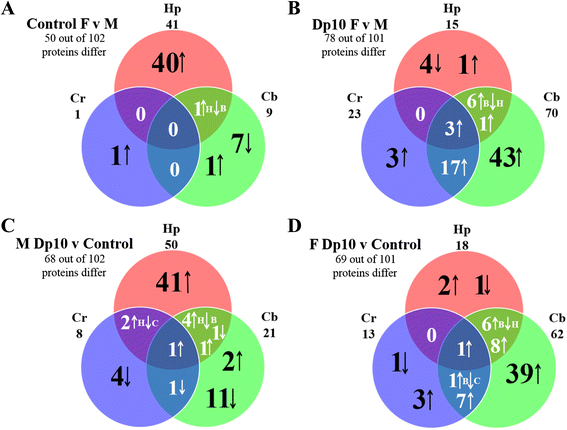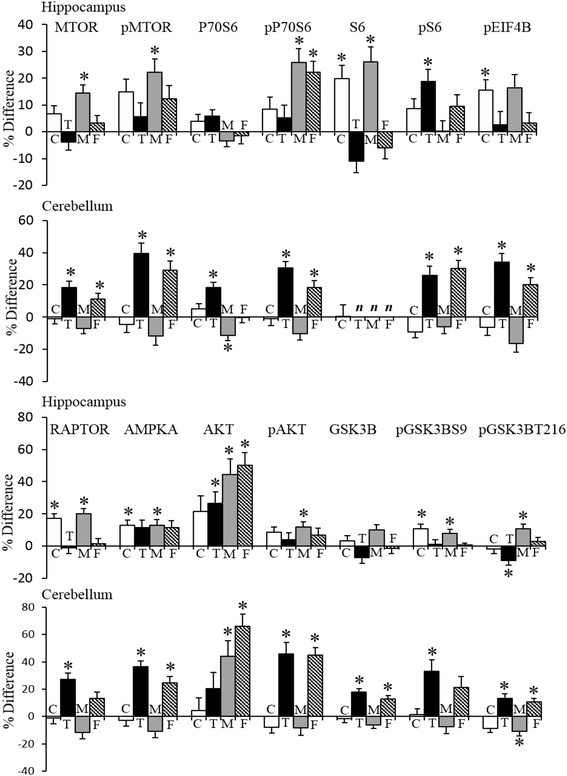Sex differences in protein expression in the mouse brain and their perturbations in a model of Down syndrome
- PMID: 26557979
- PMCID: PMC4640233
- DOI: 10.1186/s13293-015-0043-9
Sex differences in protein expression in the mouse brain and their perturbations in a model of Down syndrome
Abstract
Background: While many sex differences in structure and function of the mammalian brain have been described, the molecular correlates of these differences are not broadly known. Also unknown is how sex differences at the protein level are perturbed by mutations that lead to intellectual disability (ID). Down syndrome (DS) is the most common genetic cause of ID and is due to trisomy of human chromosome 21 (Hsa21) and the resulting increased expression of Hsa21-encoded genes. The Dp(10)1Yey mouse model (Dp10) of DS is trisomic for orthologs of 39 Hsa21 protein-coding genes that map to mouse chromosome 10 (Mmu10), including four genes with known sex differences in functional properties. How these genes contribute to the DS cognitive phenotype is not known.
Methods: Using reverse phase protein arrays, levels of ~100 proteins/protein modifications were measured in the hippocampus, cerebellum, and cortex of female and male controls and their trisomic Dp10 littermates. Proteins were chosen for their known roles in learning/memory and synaptic plasticity and include components of the MAPK, MTOR, and apoptosis pathways, immediate early genes, and subunits of ionotropic glutamate receptors. Protein levels were compared between genotypes, sexes, and brain regions using a three-level mixed effects model and the Benjamini-Hochberg correction for multiple testing.
Results: In control mice, levels of approximately one half of the proteins differ significantly between females and males in at least one brain region; in the hippocampus alone, levels of 40 % of the proteins are significantly higher in females. Trisomy of the Mmu10 segment differentially affects female and male profiles, perturbing protein levels most in the cerebellum of female Dp10 and most in the hippocampus of male Dp10. Cortex is minimally affected by sex and genotype. Diverse pathways and processes are implicated in both sex and genotype differences.
Conclusions: The extensive sex differences in control mice in levels of proteins involved in learning/memory illustrate the molecular complexity underlying sex differences in normal neurological processes. The sex-specific abnormalities in the Dp10 suggest the possibility of sex-specific phenotypic features in DS and reinforce the need to use female as well as male mice, in particular in preclinical evaluations of drug responses.
Keywords: Cerebellum; Dp(10)1Yey; Hippocampus; Intellectual disability; Learning and memory deficits; Mouse chromosome 10; S100B; TRPM2; Trisomy 21.
Figures







Similar articles
-
Trisomy of Human Chromosome 21 Orthologs Mapping to Mouse Chromosome 10 Cause Age and Sex-Specific Learning Differences: Relevance to Down Syndrome.Genes (Basel). 2021 Oct 26;12(11):1697. doi: 10.3390/genes12111697. Genes (Basel). 2021. PMID: 34828303 Free PMC article.
-
Context Fear Conditioning in Down Syndrome Mouse Models: Effects of Trisomic Gene Content, Age, Sex and Genetic Background.Genes (Basel). 2021 Sep 28;12(10):1528. doi: 10.3390/genes12101528. Genes (Basel). 2021. PMID: 34680922 Free PMC article.
-
Protein profiles in Tc1 mice implicate novel pathway perturbations in the Down syndrome brain.Hum Mol Genet. 2013 May 1;22(9):1709-24. doi: 10.1093/hmg/ddt017. Epub 2013 Jan 24. Hum Mol Genet. 2013. PMID: 23349361 Free PMC article.
-
Mouse models of Down syndrome: gene content and consequences.Mamm Genome. 2016 Dec;27(11-12):538-555. doi: 10.1007/s00335-016-9661-8. Epub 2016 Aug 18. Mamm Genome. 2016. PMID: 27538963 Free PMC article. Review.
-
The genetic background and application of Down syndrome mouse models.Yi Chuan. 2018 Mar 20;40(3):207-217. doi: 10.16288/j.yczz.17-279. Yi Chuan. 2018. PMID: 29576544 Review.
Cited by
-
Phenotype microarrays reveal metabolic dysregulations of neurospheres derived from embryonic Ts1Cje mouse model of Down syndrome.PLoS One. 2020 Jul 30;15(7):e0236826. doi: 10.1371/journal.pone.0236826. eCollection 2020. PLoS One. 2020. PMID: 32730314 Free PMC article.
-
Medial preoptic area in mice is capable of mediating sexually dimorphic behaviors regardless of gender.Nat Commun. 2018 Jan 18;9(1):279. doi: 10.1038/s41467-017-02648-0. Nat Commun. 2018. PMID: 29348568 Free PMC article.
-
Innate Immune System Activation and Neuroinflammation in Down Syndrome and Neurodegeneration: Therapeutic Targets or Partners?Front Aging Neurosci. 2021 Sep 16;13:718426. doi: 10.3389/fnagi.2021.718426. eCollection 2021. Front Aging Neurosci. 2021. PMID: 34603007 Free PMC article. Review.
-
Gene Expression Studies in Down Syndrome: What Do They Tell Us about Disease Phenotypes?Int J Mol Sci. 2024 Mar 4;25(5):2968. doi: 10.3390/ijms25052968. Int J Mol Sci. 2024. PMID: 38474215 Free PMC article. Review.
-
Dissection of a Down syndrome-associated trisomy to separate the gene dosage-dependent and -independent effects of an extra chromosome.Hum Mol Genet. 2023 Jun 19;32(13):2205-2218. doi: 10.1093/hmg/ddad056. Hum Mol Genet. 2023. PMID: 37014740 Free PMC article.
References
LinkOut - more resources
Full Text Sources
Other Literature Sources
Molecular Biology Databases
Research Materials
Miscellaneous

